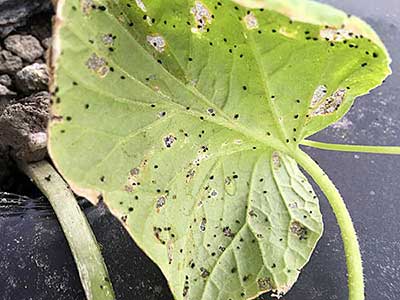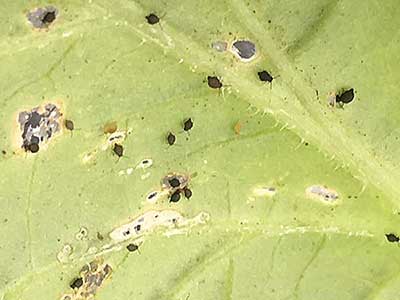
Pest: Garden Springtails (Collembolla)
Pest/disease identification and lifecycle, most common symptoms and crops affected:
Springtails are a very diverse group of soil dwelling arthropods, that largely feed on decaying organic matter. As such, most springtail species are playing a beneficial role in a healthy soil’s food web. That knowledge may be of little relief, however, if your young crop is one of the rare victims beset upon by large numbers of the garden springtail, Bourltiella hortensis.

At a glance, garden springtails and their damage resemble very much that of flea beetles, but springtails lack wings and are not true insects. They can be pale yellow to dark brown or gray. One defining feature of springtails is a tail-like appendage at the tip of their abdomen that they can use to launch themselves into the air, which is also the source of their name. Because they can’t actually fly, and because they favor tender young leaves, damage is typically restricted to cotyledons, and the first few true leaves, low to the ground. Garden springtails are generalists and have been found feeding on squash, cucumber, beets, chard, beans, and even onions. However, the only reports of significant damage in New England that I’ve been made aware of are on young cucurbit transplants such as squash and cucumbers.
Though severe damage is very rare, large populations could set back young seedlings or even result in crop failure in extreme cases. Springtail life-cycles are short (less than 3 weeks from egg to sexual maturity), and females can lay up to 400 eggs in their lifetime, so populations could build up fairly quickly under favorable conditions. Conditions favorable to springtails are high in decaying organic matter and with protection from drying out, as they require fairly humid surroundings.

Management options:
Cultural:
Management begins with common best practices; good sanitation to limit habitat, improved airflow to facilitate drying out between waterings, keeping greenhouse trays elevated on benches, and planting out vigorous seedlings that will grow past susceptible stages quickly. Spraying garlic on lower leaves has been suggested to deter garden springtails, though I cannot vouch for its efficacy.
Pesticides approved for use in certified organic production (as a last resort):
PyGanic is labeled for springtails.
Please note: This information is for educational purposes. Any reference to commercial products, trade or brand names is for information only, and no endorsement or approval is intended. Pesticide registration status, approval for use in organic production and other aspects of labeling may change after the date of this writing. It is always best practice to check on a pesticide’s registration status with your state’s board of pesticide control, and for certified organic commercial producers to update their certification specialist if they are planning to use a material that is not already listed on their organic system plan. The use of any pesticide material, even those approved for use in organic production, carries risk — be sure to read and follow all label instructions. The label is the law. Pesticides labeled for home garden use are often not allowed for use in commercial production unless stated as such on the label.

